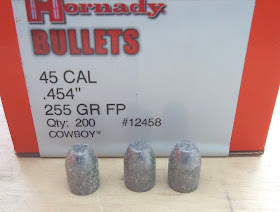Dial caliper necessary for measuring case length
Sizing and
Decapping Cases
The first operation required after cleaning
the cases is sizing. That is required in
order to hold the bullet as the case expands upon firing. For handgun cases a tungsten carbide die is
the best option. That eliminates the need for lubrication that you would need
in a typical steel die. While the older steel dies are cheaper they are not as
good an investment as the tungsten types which are made by all makers. The sizing die also decaps the case meaning
the old primer is knocked out. If you have cases that have Berdan primers,
discard them. They have two off center holes which will break your decapping
assembly. The Boxer primer has a center hole which is the better way to go. You
will have some feel when sizing which is normal. If it is too easy or hard then
you have a problem. Too easy might mean
a split case and too hard can mean that there is a smaller case inside or some
dirt or a small pebble.
45-70 Ammo
Rifle cases are somewhat different in that
there are no tungsten dies available for them. You need to lube the case body.
Failure to do so will result in a case getting stuck in the die, requiring a
difficult process to get the case out. Several makers make a stuck case remover
kit to address that problem. There are various ways to lube including a lube
pad or a paste. The body needs to be lubed but you don’t want to put too much
around the neck and shoulder. If you do that you will have dents in the
shoulder, which while not damaging look bad. In some instances you will have to
disassemble the die and clean it out. The inside of the neck should be lubed
with a dry lube so it is easier to pull the case out of the die. When you size
a rifle case the neck is made too small and the neck expander brings the neck
to the proper dimensions. There are several types of dies including neck
sizing, full length and small base dies. The best option for typical reloading
is the standard full length verity. Like the handgun dies you screw the sizing
die down to touch the shell holder with the handle all the way down. Since
rifle cases are larger and require more effort to size a larger press is
desirable.
Favorite lube for rifle cases
Rifle cases may stretch so it is necessary to
check the length. Cases that are too long may be difficult to chamber and can
cause high pressure and inconsistent ammo. What happens is the neck is shoved
into the rifling which constricts it, causing these problems. You need a dial
caliper or a case length gauge to check out the length. All of the reloading
manuals give the proper length required for each round. If the length is ok you
should chamfer the inside of the neck a little. That just cleans it a little and may make it easier to seat the
bullet. Just a little is enough. You can buy that tool as well as various case
trimmers from different manufactures. For the case trimmer you will need to buy
the correct collets and pilots. All of
this equipment is necessary to produce quality ammo
Here is a
u-tube video on sizing handgun cases. Much of that will apply to rifle brass.
http://www.youtube.com/watch?v=LeHaGT-vWkI&feature=youtu.be











